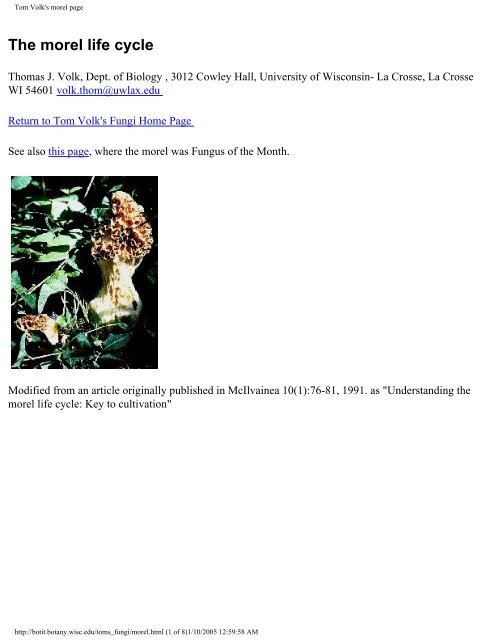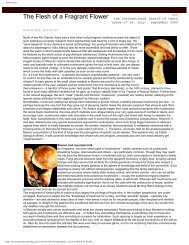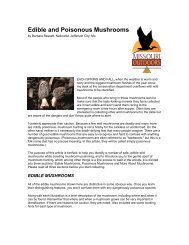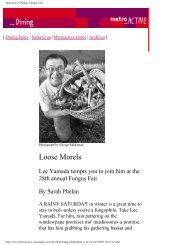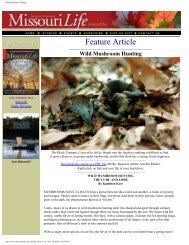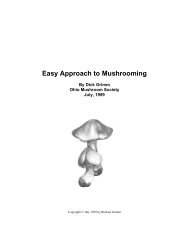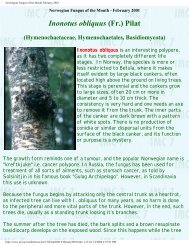Tom Volk's morel page - The Mushroom Hunter
Tom Volk's morel page - The Mushroom Hunter
Tom Volk's morel page - The Mushroom Hunter
You also want an ePaper? Increase the reach of your titles
YUMPU automatically turns print PDFs into web optimized ePapers that Google loves.
<strong>Tom</strong> <strong>Volk's</strong> <strong>morel</strong> <strong>page</strong><strong>The</strong> <strong>morel</strong> life cycleThomas J. Volk, Dept. of Biology , 3012 Cowley Hall, University of Wisconsin- La Crosse, La CrosseWI 54601 volk.thom@uwlax.eduReturn to <strong>Tom</strong> <strong>Volk's</strong> Fungi Home PageSee also this <strong>page</strong>, where the <strong>morel</strong> was Fungus of the Month.Modified from an article originally published in McIlvainea 10(1):76-81, 1991. as "Understanding the<strong>morel</strong> life cycle: Key to cultivation"http://botit.botany.wisc.edu/toms_fungi/<strong>morel</strong>.html (1 of 8)1/10/2005 12:59:58 AM
<strong>Tom</strong> <strong>Volk's</strong> <strong>morel</strong> <strong>page</strong><strong>The</strong> <strong>morel</strong>, one of the most prized and most delicious mushrooms, has finally been cultivated. <strong>The</strong> <strong>morel</strong>is perhaps the best known of the edible fungi, since it is easily identified even by those who have but aslight knowledge of mycology, one of Christiansen's Infallible Four. Although many "lesser"mushrooms are easily cultivated, e.g. Agaricus brunnescens (= A. bisporus), Pleurotus spp., andshiitake, the <strong>morel</strong> has defied all attempts at consitent indoor cultivation until very recently.Here in the Midwest, one of the major pleasures of the spring season is going out in the woods after thesnow melts to see the variety of ephemeral plants and fungi that are not present at other times of the yearbecause of shading by large deciduous trees. Almost as an added bonus, it is possible that if one findssome dead elm trees, old apple orchards, some black cherry trees, or the results of a previous year's fire,and if there has been enough rain and if the temperature is neither to hot nor too cold and if the winterhas been neither too mild nor too severe, and if one happens to be at the right place at the right time, onemay also find <strong>morel</strong>s. It is not easy to predict in advance of a hunt whether there will be some <strong>morel</strong>sfound in a particular place, even in a known "<strong>morel</strong> spot." <strong>The</strong> thrill of the hunt is precisely what makes<strong>morel</strong>ling so exciting... and often so frustrating. Nearly every <strong>morel</strong> hunter has a ready list of excuseswhy no <strong>morel</strong>s are being found: too hot, too cold, not enough rain, too much rain, not enough humidity,too humid, the tree hasn't been dead long enough, the tree's been dead too long, the may apples aren'tblooming yet, the oak leaves aren't yet the size of a squirrel's ear, and so on. <strong>The</strong> apparent lack ofidentifiable consistent conditions that lead to wild <strong>morel</strong> fruiting has been a major deterrent inestablishing protocols for artificial <strong>morel</strong> cultivation.http://botit.botany.wisc.edu/toms_fungi/<strong>morel</strong>.html (2 of 8)1/10/2005 12:59:58 AM
<strong>Tom</strong> <strong>Volk's</strong> <strong>morel</strong> <strong>page</strong>Almost as if to further confound thefacts, <strong>morel</strong>s fruit in the western UnitedStates in a much different manner. <strong>The</strong>yrarely have any relationship withparticular plants or trees, but insteadappear most often in a variety ofdisturbed habitats, especially after forestfires, in logging "skid trails," and inhorticultural plantings, especially in"bark dust." A trip in 1991 to theMalheur National Forest in easternOregon revealed <strong>morel</strong>s coming up inplaces and under conditions I would noteven consider looking in the midwest oreast. On the site of a massive forest firethe previous year, we saw literally hundreds of <strong>morel</strong>s within a few hundred square feet, and the firecovered several hundred acres, so one can imagine the large number of <strong>morel</strong>s during the entire fruitingseason. <strong>The</strong> snow had melted about three weeks earlier at the site we visited, and, although the groundappeared to be quite dry, the <strong>morel</strong>s were appearing everywhere, especially on the sides of the holescreated where trees burned well into the ground. According to area foresters, there had not been <strong>morel</strong>son this site in any previous years, probably not since fires ravaged the area 100 years previously. <strong>The</strong>ecological aspects of the situation, e.g. the role of <strong>morel</strong> mycelium in the healthy forest, is not yet clearand is often confusing and frustrating for those of us looking for a consistent pattern.It is precisely this frustration and overalllack of knowledge as well as the general"mystique" that envelopes the <strong>morel</strong>,that has generated the excitement of thepatenting of a process to grow <strong>morel</strong>s(Morchella sp.) under controlledconditions (U.S. Patent nos. 4,594,809and 4,757,640). Most people ask thesame few questions: does the processreally work? Is the process repeatableand consistent? Why are <strong>morel</strong>s sodifficult to fruit under controlledconditions? If mushroom growers canget Agaricus, shiitake and oysters mushrooms to form, why should the <strong>morel</strong> be different? <strong>The</strong> answersto these questions lie in an understanding of the life cycle of the <strong>morel</strong>.http://botit.botany.wisc.edu/toms_fungi/<strong>morel</strong>.html (3 of 8)1/10/2005 12:59:58 AM
<strong>Tom</strong> <strong>Volk's</strong> <strong>morel</strong> <strong>page</strong>Figure 1 is a representation ofthe <strong>morel</strong> life cycle (Volk and Leonard 1990, Volk and Leonard, 1989a). Even a glance at the figure willreveal a stage of the <strong>morel</strong> life cycle not present in the other cultivated mushrooms: the sclerotium. <strong>The</strong>sclerotium of the <strong>morel</strong> is a relatively large structure (1mm -5 cm diameter) composed of large cells withvery thick walls that allow the fungus to survive adverse natural conditions, such as winter. In thespring, the sclerotium has two options for germination; to form a new mycelium or to form a fruitingbody. Unfortunately for the potential grower, it is very easy to get the sclerotia to form a new myceliumbut very difficult to force it to form a fruiting body. Very specific conditions of nutrition, humidity,carbon dioxide levels and temperature must be met for primordia to form. Although difficult, however,this part is relatively easy. <strong>The</strong> primordium is very prone to abort at this very young stage if not giventhe proper set of conditions, which may be very different from those that allowed their initiation. It is atbest a very tricky business.Attempts have been made for many years to cultivate <strong>morel</strong>s. <strong>The</strong> high price that is commanded by thesedelicacies ($15-$20 per pound at farmers' markets in Wisconsin--even with a plentiful crop) has temptedhttp://botit.botany.wisc.edu/toms_fungi/<strong>morel</strong>.html (4 of 8)1/10/2005 12:59:58 AM
<strong>Tom</strong> <strong>Volk's</strong> <strong>morel</strong> <strong>page</strong><strong>The</strong> patents themselves (see also Volk and Leonard,1989b) describe a process for formation of sclerotiathat are competent to produce fruiting bodies. Morelsclerotia do not normally form until the nutrients of asubstrate have almost run out. One trick to forminglarge sclerotia is to inoculate <strong>morel</strong> mycelium on anutrient-poor substrate (such as soil) and allow it touse its limited nutrient reserves to reach a nearbynutrient-rich substrate. <strong>The</strong> nutrients are thentranslocated back into the old mycelia where thesclerotia are formed as they begin to store thenutrients as lipids. <strong>The</strong>se sclerotia can often be quitelarge and have very much the same consistency and slippery feel as walnuts. When the sclerotia aremature, the nutrient source is removed, and water is "percolated" between the sclerotia in the soil,perhaps simulating spring rains. After 10-12 days, small primordia appear, and, if the conditions arecorrect, the <strong>morel</strong>s mature in 12-15 days. On the surface it seems like a very simple process, but as withall mushrooms, there are many points at which the grower can make mistakes and lose the entire crop.As far as species go, <strong>morel</strong> taxonomy is a big mess. In the midwest we have what I (and most people)believe are just three species of <strong>morel</strong>s:Morchella esculenta, the gray <strong>morel</strong>, which is probably the same asM.crassipes, pictured at the top of this <strong>page</strong>.http://botit.botany.wisc.edu/toms_fungi/<strong>morel</strong>.html (6 of 8)1/10/2005 12:59:58 AM
<strong>Tom</strong> <strong>Volk's</strong> <strong>morel</strong> <strong>page</strong>Morchella conica, the black <strong>morel</strong>.Morchella semilibera, the half-free <strong>morel</strong>.http://botit.botany.wisc.edu/toms_fungi/<strong>morel</strong>.html (7 of 8)1/10/2005 12:59:58 AM
<strong>Tom</strong> <strong>Volk's</strong> <strong>morel</strong> <strong>page</strong>I was very fortunate to visit Meramec State Parkin Missouri the weekend of April 27, 1996 toparticipate in the Missouri MycologicalSociety's MOREL MADNESS foray, at theinvitation of Ken Gilberg and Jim Winn. It wasa lot of fun, and I recommend this foray veryhighly. <strong>The</strong> picture is of the <strong>morel</strong> king (whofound 95+ <strong>morel</strong>s) the <strong>morel</strong> queen (who found70+ <strong>morel</strong>s), the <strong>morel</strong> prince (who found thelargest <strong>morel</strong>), and last year's <strong>morel</strong> king,holding the 3.75 lb. Gyromitra caroliniana hefound. Most of the <strong>morel</strong>s were found on southslopes, mostly under recently dead elm trees, butalso under living ash and oak trees.REFERENCESLeonard, Thomas J. and Thomas J. Volk, 1992. Production of new edible mushrooms in North America:shiitake and <strong>morel</strong>s. in Frontiers in Industrial Mycology. Gary F. Leatham editor. Chapman Hall. p. 1-23Ower, R., 1982. Notes on the development of the <strong>morel</strong> ascocarp. Mycologia 74: 142-144.Ower, R., G. Mills, and J. Malachowski, 1986. Cultivation of Morchella. U.S. Patent No. 4,594,809.Ower, R., G. Mills, and J. Malachowski, 1988. Cultivation of Morchella. U.S. Patent No. 4,757,640.Volk, Thomas J. and Thomas J. Leonard, 1989a. Experimental studies on the <strong>morel</strong>. I. Heterokaryonformation between monoascosporous isolates of Morchella. Mycologia 81: 523-531.Volk, Thomas J. and Thomas J. Leonard, 1989b. Physiological and environmental studies of sclerotiumformation and maturation in Morchella. Appl. Env. Microbiol. 55: 3095-3100.Volk, Thomas J. and Thomas J. Leonard, 1990. Cytology of the Life cycle of Morchella. MycologicalResearch 94: 399-406.This <strong>page</strong> and other <strong>page</strong>s are © Copyright 2000 by Thomas J. Volk, University of Wisconsin-LaCrosse.Return to <strong>Tom</strong> <strong>Volk's</strong> Fungi Home Pagehttp://botit.botany.wisc.edu/toms_fungi/<strong>morel</strong>.html (8 of 8)1/10/2005 12:59:58 AM


